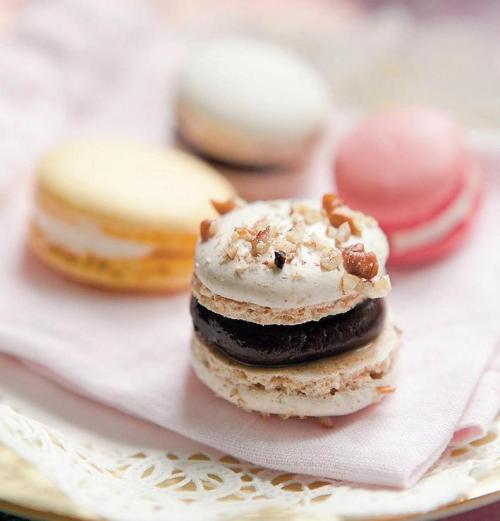Ethereal to the tongue, bright and pleasing to the eye, the dainty Parisian pastries known as macarons are tiny bites of luxury.
Made of little more than almonds, egg whites and sugar, often dyed to a bright, lacquer like sheen, the shells are tantalizingly crisp, with a slightly springy interior. Dissolving in the mouth, they give way to fillings of beguiling and delicious variety: ganache, buttercream or citrus- and whiskey-soaked concoctions dancing with complexity.
All this decadence comes at some cost. Trendy macarons are expensive to buy and intimidating to make. Rumors that they are “the new cupcake” have been greatly exaggerated. Only a person who has never executed a macaron would offer to bake them for a party.
Made of little more than almonds, egg whites and sugar, often dyed to a bright, lacquer like sheen, the shells are tantalizingly crisp, with a slightly springy interior. Dissolving in the mouth, they give way to fillings of beguiling and delicious variety: ganache, buttercream or citrus- and whiskey-soaked concoctions dancing with complexity.
All this decadence comes at some cost. Trendy macarons are expensive to buy and intimidating to make. Rumors that they are “the new cupcake” have been greatly exaggerated. Only a person who has never executed a macaron would offer to bake them for a party.

When I was assigned a story on Jialin Tian’s lovely little book “Macaron Magic” (Jayca, $17.95), I was thrilled and terrified. I fretted over where to find powdered egg whites and powdered food coloring. I didn’t own a pastry tube. I hemmed. I hawed. I postponed.
But fortune smiled upon me. Tian, who received a doctorate in electrical and computer engineering from Georgia Tech in 2004, turned out to be a patient instructor, hand-holder and email correspondent. A China native who lives in Virginia and conducts research for NASA, Tian told me she fell in love with classic macarons in Paris about a decade ago. She perfected her craft while living in Atlanta.
Her book, which includes impeccable step-by-step directions and photographs, is filled with all kinds of macarons that reflect her personal tastes: tea and espresso, coconut and lemon grass, Georgia peanuts and pecans, margaritas and mojitos. Yet there is science here, too. Tian’s book espouses the careful precision and methodology of a highly disciplined and analytical mind.
And making macaron shells is a science, let me tell you. It takes practice, and patience.
To get that authentic look, the shells should puff up and sit on little “feet.” When you sandwich them together, they are supposed to look like tiny hamburgers ― not whoopie pies. The shells are made by blending a paste of aged egg whites and almond meal with a stiff Italian meringue; then adding color if desired. “Aging” egg whites means that you let them dry overnight (or longer) in the refrigerator. Because eggs vary in size, you must weigh the whites ― all the ingredients, really ― before assembling the batter.
“Variables such as the texture of the almond flour, the temperature and state of the sugar, the moisture content of the egg whites, and the viscosity of the macaron batter,” Tian writes, “as well as random environmental variables such as ambient temperature and humidity, can all play a crucial role in macaron baking.”
No surprise that my first batch was a major failure. Delicious and chewy, but flat as Thin Mints. No feet!
I may have overmixed the batter, and the almond meal could have been too fine. (I now believe a bit of coarseness helps bind the ingredients, and the tiny bumps virtually disappear under cover of dye and shiny shell.) I committed two other no-nos: I didn’t weigh the egg whites, and I don’t think my Italian meringue was stiff (or cool) enough. You have to beat the meringue for quite a long time ― 15 or 20 minutes ― and measure the temperature along the way.
“I think the common mistake most people make is not to make the Italian meringue correctly,” Tian said.
As I started my second try, I was anxiously rehearsing how I would tell my editor this macaron story might not happen ― unless she wanted a humor piece. Still, I had a few more tricks up my sleeve. I ground my own almond meal. I upped the baking temperature from 325 to 335 degrees and doubled the thickness of the baking pan by adding a second tray.
Voila! The shells puffed up magically. “I’ve got feet!” I emailed Tian excitedly.
She responded accordingly. “The macaron is one of the hardest pastries to make,” she said. “Even some of the most experienced pastry chefs have trouble getting them right.” (Now she tells me!) “You will be very popular at parties,” she concluded. Maybe I should rethink the cupcake thing. They really have run their course.
By Wendell Brock
(The Atlanta Journal-Constitution)
(MCT Information Services)
-
Articles by Korea Herald







![[KH Explains] How should Korea adjust its trade defenses against Chinese EVs?](http://res.heraldm.com/phpwas/restmb_idxmake.php?idx=644&simg=/content/image/2024/04/15/20240415050562_0.jpg&u=20240415144419)











![[Today’s K-pop] Stray Kids to return soon: report](http://res.heraldm.com/phpwas/restmb_idxmake.php?idx=642&simg=/content/image/2024/04/16/20240416050713_0.jpg&u=)